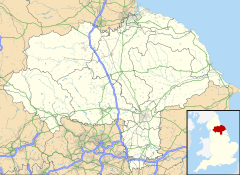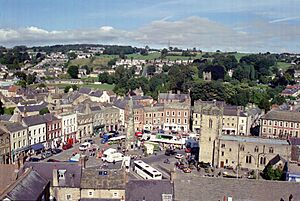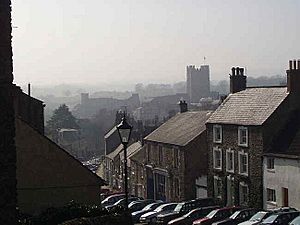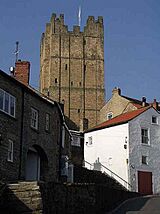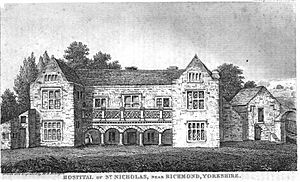Richmond, North Yorkshire facts for kids
Quick facts for kids Richmond |
|
|---|---|
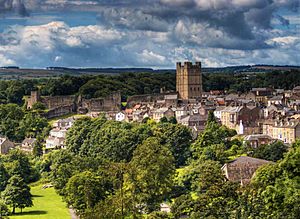 Historic Richmond, with its Norman castle |
|
| Population | 8,413 (2011 census) |
| OS grid reference | NZ170009 |
| • London | 210 mi (340 km) SSE |
| Unitary authority |
|
| Ceremonial county | |
| Region | |
| Country | England |
| Sovereign state | United Kingdom |
| Post town | RICHMOND |
| Postcode district | DL10 |
| Dialling code | 01748 |
| Police | North Yorkshire |
| Fire | North Yorkshire |
| Ambulance | Yorkshire |
| EU Parliament | Yorkshire and the Humber |
| UK Parliament |
|
Richmond is a lively market town and civil parish in North Yorkshire, England. It sits where Swaledale, the upper part of the River Swale valley, opens up into the Vale of Mowbray. In 2011, about 8,413 people lived here. The town is about 13 miles (21 km) north-west of Northallerton, which is the main town of the county, and 41 miles (66 km) north-west of York.
Richmond was once part of a larger area called Yorkshire in the Domesday Book of 1086. Later, it became the main center for the Honour of Richmond in the North Riding of Yorkshire. From 1974 to 2023, Richmond was the administrative hub for the Richmondshire district. Today, Richmond is a popular spot for tourists, especially because it's close to the Yorkshire Dales National Park.
Contents
History of Richmond
Richmond in North Yorkshire has a long and interesting past. It was once the center of the Honour of Richmond, a special title held by important nobles, including the Dukes of Brittany for many years.
How Richmond Began
Richmond was started in 1071 by a nobleman named Alan Rufus. He received the land from William the Conqueror. At first, it was called Hindrelag. The name Richmond comes from Old French words meaning "Strong Hill." This name was also used for a village in Normandy. There are actually 56 other places named Richmond around the world! Richmond Castle was finished in 1086. It had a strong tower and walls that covered the area we now know as the Market Place.
Important Events in Richmond's Past
Richmond was part of an earldom, which was a special area ruled by an Earl. This earldom was sometimes held by the Dukes of Brittany until the 14th century. When John V, Duke of Brittany, died in 1399, King Henry IV took control of Richmond. The town was lucky during The Great Raid of 1322 when Scottish raiders were bribed to leave it alone.
In 1453, the earldom was given to Edmund Tudor. When his son became King Henry VII in 1485, Richmond became part of the Crown's lands. During the Wars of the Three Kingdoms, the castle was taken over by the Covenanter Army.
In 1608, Robert Willance became the first leader of Richmond. A few years before, he survived a terrible fall while hunting near Whitcliffe Scar. His horse bolted in thick fog and fell over 200 feet. Willance survived with a broken leg and built a monument to show his thanks.
Growth and Change in Richmond
Richmond grew a lot in the late 1600s and 1700s. This was thanks to the booming lead mining industry in nearby Arkengarthdale. Many of the town's beautiful Georgian buildings you see today, especially on Newbiggin and Frenchgate, come from this time. One of Europe's first gas works was even built here in 1830. A military base, Richmond Barracks, was built in 1877.
During the First World War, Richmond's own Green Howards Regiment formed many battalions. The castle became a training camp for new soldiers. In 1915, troops started using the area south of Richmond, which later became Catterick Camp.
In 1916, a group of "conscientious objectors" called the Richmond Sixteen were held at the castle. They refused to fight or help in the war. They were sent to France, sentenced to death, but their sentence was changed to ten years in prison. They were released in 1919. The castle's cells were even used to hold prisoners during the Second World War.
In June 1927, Richmond was a great place to see a total solar eclipse. A plaque on Reeth Road marks this special event.
Richmond's Government
Who Represents Richmond?
The person who represents Richmond and Northallerton in the UK Parliament is Rishi Sunak. He is a member of the Conservative Party and was formerly the Prime Minister of the United Kingdom. He has been the Member of Parliament for this area since 2015. This area has been a very safe seat for the Conservative Party since 1910.
Where is Richmond?
Richmond is about 16 miles (26 km) north-west of Northallerton, the county town. It sits right on the eastern edge of the Yorkshire Dales National Park. The town is in a valley called Swaledale, named after the River Swale that flows through it. The River Swale is known as one of the fastest-flowing rivers in England.
The closest official weather station to Richmond is in Leeming, about 12 miles (19 km) to the south-east. Temperatures there have ranged from a hot 33.5°C (92.3°F) in August 1990 to a very cold -17.9°C ( -0.2°F) in December 2010.
| Climate data for Leeming (North Yorkshire): elevation: 32 m (105 ft) Average maximum and minimum temperatures, and average rainfall recorded between 1991 and 2020 by the Met Office. |
|||||||||||||
|---|---|---|---|---|---|---|---|---|---|---|---|---|---|
| Month | Jan | Feb | Mar | Apr | May | Jun | Jul | Aug | Sep | Oct | Nov | Dec | Year |
| Mean daily maximum °C (°F) | 7.0 (44.6) |
7.8 (46.0) |
10.2 (50.4) |
13.0 (55.4) |
16.0 (60.8) |
18.7 (65.7) |
21.0 (69.8) |
20.5 (68.9) |
17.9 (64.2) |
13.9 (57.0) |
9.9 (49.8) |
7.2 (45.0) |
13.6 (56.5) |
| Mean daily minimum °C (°F) | 1.1 (34.0) |
1.1 (34.0) |
2.2 (36.0) |
3.9 (39.0) |
6.5 (43.7) |
9.6 (49.3) |
11.6 (52.9) |
11.4 (52.5) |
9.3 (48.7) |
6.5 (43.7) |
3.4 (38.1) |
1.0 (33.8) |
5.65 (42.17) |
| Average precipitation mm (inches) | 53.8 (2.12) |
44.0 (1.73) |
39.4 (1.55) |
46.2 (1.82) |
43.8 (1.72) |
58.8 (2.31) |
56.2 (2.21) |
65.3 (2.57) |
56.9 (2.24) |
65.0 (2.56) |
64.8 (2.55) |
59.5 (2.34) |
653.7 (25.74) |
| Average precipitation days (≥ 1.0 mm) | 12.0 | 10.0 | 8.5 | 9.0 | 8.7 | 9.4 | 9.3 | 10.1 | 9.1 | 11.1 | 12.2 | 11.9 | 121.4 |
| Mean monthly sunshine hours | 58.1 | 81.7 | 121.5 | 153.8 | 195.0 | 175.9 | 185.5 | 171.2 | 132.7 | 93.4 | 63.7 | 54.2 | 1,486.7 |
| Source: Met Office | |||||||||||||
People of Richmond
Population and Background
According to the 2011 United Kingdom census, Richmond had a total population of 8,413 people. This included 4,374 females and 4,039 males. Most of the people (95.8%) identified as white British. A smaller number identified as other white (1.4%), Asian (1.1%), or black (0.8%).
Most residents (93.8%) were born in the United Kingdom. About 3.3% were from European Union countries, and 2.5% were from other parts of the world. When it came to beliefs, 71.7% said they had religious beliefs. Of those, 70.4% were Christian. About 21.4% said they had no religion.
An interesting fact about Richmond's population is that 2% of the people were born in Germany. This is because of the large army base, Catterick Garrison, nearby.
How Richmond's Population Has Changed
The table below shows how the number of people living in Richmond has changed over many years, from 1801 to 2011.
| Year | 1801 | 1811 | 1821 | 1831 | 1841 | 1851 | 1881 | 1891 | 1901 | 1911 | 1921 | 1931 | 1951 | 1961 | 1971 | 1981 | 1999 | 2001 | 2011 |
|---|---|---|---|---|---|---|---|---|---|---|---|---|---|---|---|---|---|---|---|
| Population | 2,861 | 3,056 | 3,546 | 3,900 | 3,992 | 4,106 | 4,502 | 4,216 | 3,837 | 3,934 | 3,887 | 4,769 | 6,166 | 5,776 | 7,245 | 7,700 | 8,480 | 8,178 | 8,413 |
| Sources: | |||||||||||||||||||
Richmond's Economy
Richmond's economy relies on a few key things. Since it's a "gateway" town to the Yorkshire Dales, tourism is very important. Many people visit to explore the beautiful national park.
Jobs and Businesses
The biggest influence on jobs in Richmond is the Catterick Garrison army base nearby. It's becoming the largest population center in the Richmondshire area. You'll find both big national shops like Lidl and Boots, as well as many local independent shops, restaurants, and pubs. These all provide jobs for people in the town. The Gallowfields Trading Estate, on the north side of town, has businesses like builder's merchants, car garages, and a vet's office.
Markets and Trade
Richmond has a traditional market every Saturday in its large cobbled market square. There's also an indoor market that's open all week in the town's 19th-century market hall. These markets have been around for a very long time, since 1093! The first official permission for a market was given in 1155.
Work and Housing
In 2011, about 37.6% of people aged 16–74 had full-time jobs, and 15.5% worked part-time. About 10.4% were self-employed. Many people were retired (20%) or students (6%).
The average price for a house in Richmond in early 2020 was around £241,583. This was a bit higher than the average for North Yorkshire.
Famous Places in Richmond
Richmond is full of interesting landmarks, from ancient castles to beautiful waterfalls.
Richmond Castle
Richmond Castle is right in the town center, looking over the River Swale. It's a big draw for tourists, with almost 40,000 visitors each year. Scolland's Hall, part of the castle, was once guarded by important lords.
Abbeys and Legends
Not far from the town center are the ruins of Easby Abbey, a historic monastery. It's managed by English Heritage. Next to it is Easby Hall, built in 1729. A famous local story is about the Little Drummer Boy. In the 1700s, a young soldier was sent to explore a tunnel from the castle to Easby, playing his drum to guide others. His drumming suddenly stopped, and he was never seen again. A stone marks the spot where his drumming ended.
Towers and Follies
The tall market cross, or "obelisk," was built in 1771. On the south-west side of town is Culloden Tower, a decorative building (or "folly") built in 1746 to celebrate a battle victory. It was fixed up in 1981 and is now a holiday rental. Another small folly is Oliver Duckett, a round tower built from the same stone as Richmond Castle.
Historic Homes
Swale House on Frenchgate, built around 1750, was once a grammar school and later a hospital for wounded officers in World War I. Millgate House, a bed and breakfast, is famous for its beautiful gardens.
War Memorials
Richmond has two war memorials. The Gallowgate Memorial, a Celtic cross, honors the Green Howards regiment from both World Wars. Another monument in the Friary Gardens remembers all Richmond residents who died in the two World Wars.
Natural Beauty
Richmond Falls are a short walk from the town center. To the west, on the road to Marske, is a place with the unusual name Richmond Out Moor.
Places of Worship
Richmond has four churches that are still in use today:
- The Church of England's St Mary the Virgin
- The Roman Catholic St Joseph and St Francis Xavier
- Richmond Methodist Church
- Influence Church, which started in 1950 as Richmond Pentecostal Church.
Older religious buildings include Holy Trinity Church, which is no longer used for regular services, and the 15th-century bell tower of the former Greyfriars monastery.
Getting Around Richmond
Train Travel
Richmond Railway Station opened in 1846 but closed in 1968. After being a garden center for many years, it was renovated and reopened in 2007 as "The Station." It's now a place for community events and businesses. The closest main train station to Richmond is Darlington, about 13 miles (21 km) away.
Bus Services
Buses from Arriva North East connect Richmond to Darlington and Catterick Garrison. Other bus companies offer routes to places like Barnard Castle, Northallerton, Leyburn, and Ripon. The "Little White Bus," run by volunteers, connects Richmond to villages in Swaledale.
Roads and Bridges
Two main roads pass through Richmond. The A6108 is the main way to get into town from the A1(M) motorway and continues west towards Leyburn. The A6136 connects to Catterick Garrison across Mercury Bridge. Mercury Bridge is a historic bridge over the River Swale. In 2000, heavy flooding damaged the bridge, but it was repaired and reopened later that year.
Air Travel
The closest airport is Teesside International Airport, about 18 miles (29 km) north-east of Richmond.
Learning in Richmond
Richmond has several schools for different age groups.
Secondary Schools
The town has two secondary schools:
- Richmond School is a large school with a sixth form, specializing in performing arts, science, and math.
- St Francis Xavier School is a smaller school for students aged 11–16. It's a joint Roman Catholic and Church of England school.
Primary Schools
There are also three primary schools:
- Trinity Academy (formerly Richmond C of E)
- Richmond Methodist School
- St Mary's Roman Catholic School
Sports and Fun in Richmond
Richmond offers a variety of sports and cultural activities for everyone.
Sports Teams
- Football: The town's football club, Richmond Town F.C., started in 1945. They play their games at the Earl's Orchard ground.
- Rugby: Richmond is also home to Richmondshire Rugby Union Football club.
- Cricket: Richmondshire Cricket Club plays in the North Yorkshire and South Durham Cricket League. They have won the league title five times and a national championship once in 2018.
Richmond was also the starting point for a stage of the 2018 Tour de Yorkshire cycling race. The town's old racecourse opened in 1765 but closed in 1891. It's still used for horse training and walking.
Media and Filming
Richmond has two local newspapers: Northern Echo and Darlington & Stockton Times. Local TV news comes from BBC North East and ITV Tyne Tees. The town has several radio stations, including BBC Radio York and Greatest Hits Radio.
Richmond has been a filming location for several TV shows and movies, such as The Fast Show and All Creatures Great and Small.
Arts and Music
The official gallery of artist Mackenzie Thorpe is in Richmond. Local artist Lucy Pittaway was the official artist for the Tour de Yorkshire from 2016 to 2018.
Richmondshire Concerts is a group that puts on classical music concerts six times a year. Richmond Live was an annual music festival held by the river, but it was stopped after 2019.
Cinema and Theatre
Richmond has a two-screen cinema that opened in 2007 in the old railway station building. The Georgian Theatre Royal in Richmond, built in 1788, is the most complete 18th-century theatre in the UK. It was restored and reopened in 1963 and now includes a museum.
Community Events
The Richmond Meet is an annual fair held every Whit Monday. It includes a parade and fun rides in the market square. It has been running for over 120 years!
Richmond is also twinned with Vinstra, Norway, and Saint-Aubin-du-Cormier, France.
Public Services in Richmond
Healthcare
The town is served by the Friary Community Hospital, which opened in 1999. It provides non-emergency care and general doctor services. The Victoria Ward in the hospital has 18 beds for various needs, including recovery and comfort care. The old Victoria Hospital, which closed in 1999, is now used as funeral director's offices. There's also a smaller doctor's office called Quakers Lane Surgery. A very old hospital, St. Nicholas house, dates back to 1137.
Ambulances are run by the Yorkshire Ambulance Service. The town is also covered by the Great North Air Ambulance for emergencies.
Emergency Services
North Yorkshire Police and North Yorkshire Fire and Rescue Service both have stations in the same building on I'Anson Road. Water is supplied by Yorkshire Water.
Information Centre
The Richmond Information Centre is located in the town's Victorian-era Market Hall. It's now run by volunteers and helps visitors and locals find out about attractions and services in the area, including the Yorkshire Dales National Park.
Famous People from Richmond
Many notable people have either been born in Richmond or lived there.
Born in Richmond
- Rob Andrew, a famous rugby player.
- Peter Auty, an opera singer known for "Walking In The Air" from The Snowman.
- George Bell, who founded a publishing company.
- Amanda Sonia Berry, CEO of BAFTA.
- Henry Greathead, who invented the lifeboat.
- Theo Hutchcraft, half of the music duo, Hurts.
- Zoe Lee, an Olympic silver medalist in rowing.
- Tanya Bardsley, a model.
- Tim Rodber, another rugby international.
- Fran Summers, a model.
Residents of Richmond
- Lord Baden-Powell, who started the scouting movement.
- Lewis Carroll, the author of Alice in Wonderland, attended Richmond School.
- Charles Grey, 2nd Earl Grey, a former British Prime Minister, also went to Richmond School.
- Brenda Hale, Baroness Hale of Richmond, a top judge in the UK.
- Peter Inge, Baron Inge, a former head of the British army.
- Joanne Jackson, an Olympic swimmer.
- Mackenzie Thorpe, a well-known artist.
- Peter Robinson, author of the DCI Banks series.
Richmond's Coat of Arms
|
See also
 In Spanish: Richmond (Yorkshire del Norte) para niños
In Spanish: Richmond (Yorkshire del Norte) para niños


